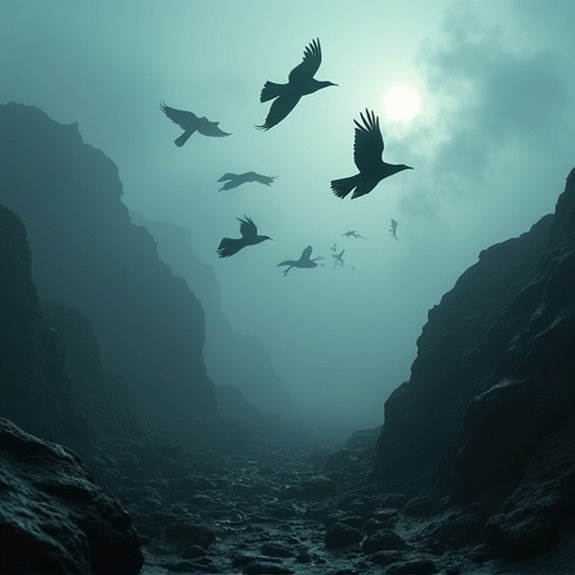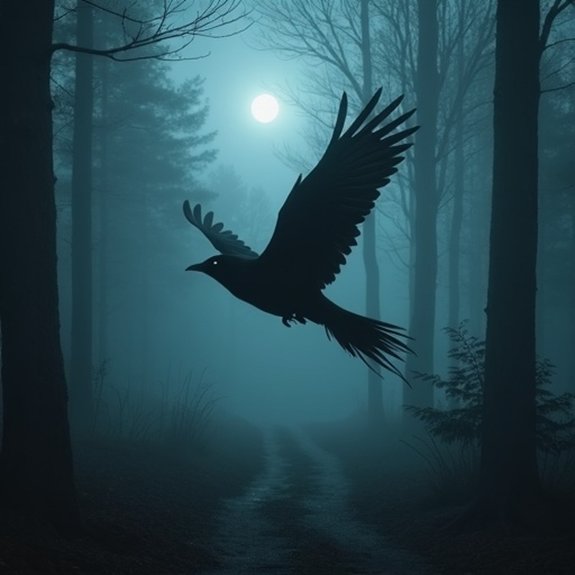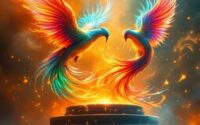The Underworld Birds: Psychopomps
Throughout history, certain birds have appeared at humanity’s darkest moments, serving as messengers between the living and the dead. They’re called psychopomps—winged guides that ancient civilizations believed escort souls to the afterlife. From Egyptian tombs to modern deathbed visions, these creatures persist in human consciousness. But what drives this universal connection between birds and death? The answer lies buried in millennia of hieroglyphs, folklore, and unexplained encounters.
Introduction

While ancient mythologies often depicted birds as messengers between heaven and earth, numerous cultures also associated certain avian species with the underworld and death. These psychopomp birds didn’t merely symbolize mortality; they actively guided souls through their final journey. Ravens, crows, owls, and vultures appeared consistently across civilizations as death’s companions, earning reverence and fear in equal measure.
From Greek mythology‘s owl accompanying Hades to Norse tradition’s ravens serving Odin, these birds possessed unique qualities that linked them to the afterlife. Their nocturnal habits, carrion-feeding behaviors, and distinctive calls reinforced supernatural associations. They weren’t viewed as harbingers of doom but as essential conductors ensuring safe passage between worlds. Understanding these avian psychopomps reveals how humanity’s relationship with death has always intertwined with observations of the natural world.
Ancient Egyptian Hieroglyphic Depictions
Though ancient Egyptians developed one of history’s most sophisticated writing systems, their hieroglyphic representations of underworld birds reveal profound spiritual beliefs about death and rebirth. The ba-bird, depicted with a human head atop a falcon’s body, symbolized the soul’s ability to travel between worlds. Tomb walls throughout the Valley of the Kings showcase these creatures guiding deceased pharaohs through the afterlife’s treacherous passages.
The benu-bird, often rendered as a heron with golden plumage, represented renewal and resurrection. Hieroglyphic texts from the Book of the Dead frequently show this phoenix-like entity perched beside Osiris’s throne. Scribes also carved images of sacred ibises accompanying Thoth, who’d record the deceased’s heart-weighing ceremony results. These artistic depictions weren’t mere decoration—they served as magical instruments ensuring safe passage through death’s domain.
Notable Cases or Sightings

When did modern encounters with underworld birds first capture public attention? The 1961 Point Pleasant sightings marked a turning point. Witnesses reported large, dark-winged creatures appearing before local tragedies, including the Silver Bridge collapse that killed forty-six people. These accounts sparked nationwide interest in psychopomp phenomena.
Similar reports emerged from Japan following the 2011 tsunami. Survivors described seeing massive black birds circling above devastated areas where thousands had perished. Local folklore experts linked these sightings to traditional yatagarasu legends.
In 2019, Mexico City’s Day of the Dead celebrations brought unexpected testimony. Multiple attendees photographed unusual crow formations that appeared to guide luminous orbs through cemetery grounds. Ornithologists couldn’t explain the birds’ synchronized movements or their apparent interaction with unexplained light phenomena.
Common Theories or Explanations
These documented encounters have prompted researchers to propose several explanations for underworld bird phenomena. Jungian psychologists suggest they’re archetypal manifestations from humanity’s collective unconscious, representing death’s transformation. Neurologists argue they’re hallucinations triggered by temporal lobe activity during extreme stress or near-death experiences.
Paranormal investigators claim they’re genuine spirit guides facilitating soul transformations between domains. Some quantum physicists theorize they’re interdimensional beings visible only when consciousness shifts frequencies. Anthropologists view them as cultural constructs—psychological projections shaped by mythology and folklore.
Medical professionals often attribute sightings to hypoxia, medication effects, or grief-induced perceptual distortions. Meanwhile, occultists maintain they’re actual psychopomps serving ancient deities. Despite diverse interpretations, most researchers agree these experiences profoundly impact witnesses, regardless of their true nature or origin.
Frequently Asked Questions
How Can I Protect Myself From Encountering Psychopomp Birds?
One can’t truly avoid psychopomps since they’re drawn to souls during death’s passage. They’ll find traditional protections like salt circles or iron ineffective. Instead, one shouldn’t fear them—they’re guides, not threats to the living.
Do Psychopomp Birds Appear Differently to Children Versus Adults?
Yes, children often perceive psychopomp birds as smaller, friendlier creatures with softer features, while adults see them in their true intimidating forms. A child’s innocence acts as a filter, making death’s messengers appear less frightening.
What Sounds or Calls Do Psychopomp Birds Typically Make?
Psychopomp birds don’t make typical bird calls. Witnesses describe hearing whispered names, soft bell-like chimes, or complete silence that feels heavy. Some report the birds’ wings create sounds resembling distant music or rushing water.
Can Psychopomp Birds Be Photographed or Recorded on Video?
Most witnesses claim psychopomp birds don’t appear on film or digital media. Cameras typically capture empty spaces where observers swear they’ve seen the creatures. Some paranormal investigators report detecting electromagnetic anomalies during supposed encounters instead.
Are Certain Locations More Likely to Attract Psychopomp Bird Manifestations?
Yes, they’re drawn to liminal spaces where life and death intersect. Hospitals, battlefields, ancient burial grounds, and crossroads see frequent manifestations. They also appear near individuals experiencing profound grief or approaching their final moments.


